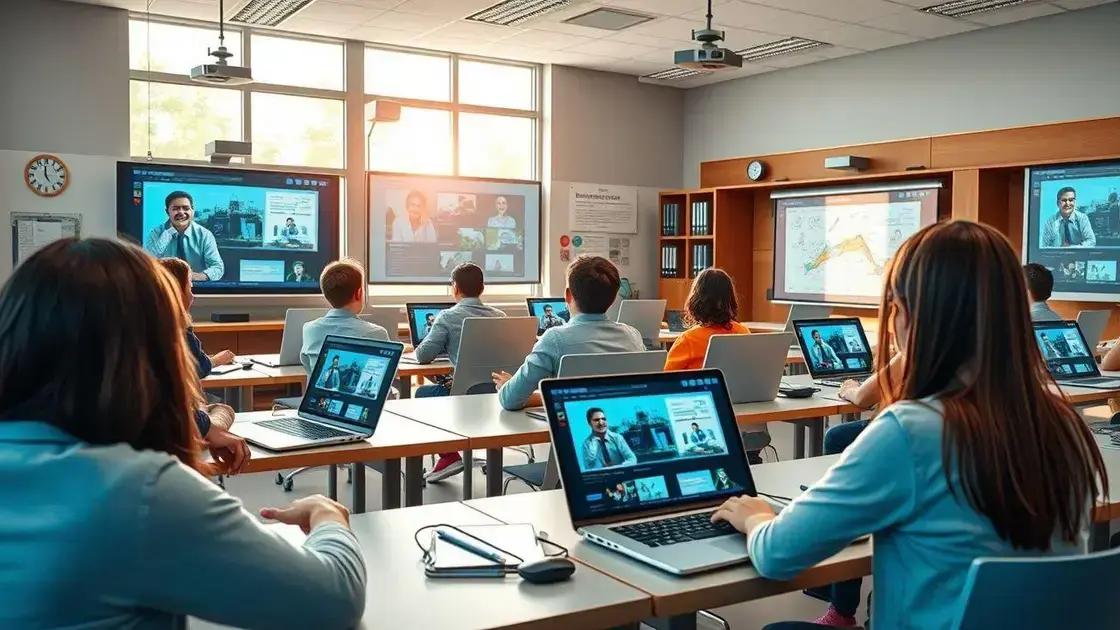Digital classrooms: redefining the future of learning

Digital classrooms enhance education by offering personalized learning experiences, improved access to resources, and tools for global collaboration, while also presenting challenges such as technology access and the need for teacher adaptation.
In today’s educational landscape, digital classrooms are transforming how students learn and engage. Have you ever wondered how technology can enhance your learning experience? Let’s dive into this fascinating topic!
Understanding digital classrooms
Understanding digital classrooms is crucial in today’s educational environment. They integrate technology into learning to enhance student engagement and collaboration. With digital tools, teachers can create interactive lessons that capture students’ attention.
Key Features of Digital Classrooms
Digital classrooms offer various features that facilitate modern learning:
- Interactive Learning: Using platforms that allow real-time collaboration among students.
- Access to Resources: Instant access to online materials, articles, and videos to boost understanding.
- Flexible Learning Environments: Students can learn anywhere, at any time, using their devices.
- Data Tracking: Teachers can monitor progress and adjust instruction based on performance.
Moreover, digital classrooms allow for personalized learning experiences. Students can learn at their own pace, reviewing materials as needed. This flexibility caters to diverse learning styles and helps maintain student motivation.
Benefits of Digital Classrooms
The benefits are extensive. For example, students can engage with interactive content that enhances understanding. They can work on group projects without being limited by physical presence, fostering teamwork. Additionally, these classrooms help bridge the gap between traditional education and the evolving landscape of technology.
By merging traditional teaching methods with innovative technologies, digital classrooms pave the way for a more inclusive and effective learning experience. Students are encouraged to think critically and creatively, preparing them for the future.
Benefits of digital classrooms for students
One of the main benefits of digital classrooms for students is enhanced engagement. With interactive tools, lessons become more lively and interesting. Students are more likely to participate actively in discussions and activities that involve technology.
Flexible Learning Opportunities
Digital classrooms provide flexible learning opportunities. Students can access materials anytime and anywhere, allowing them to learn at their own pace. This flexibility helps to cater to different learning styles and preferences, making education more personalized.
- Self-Paced Learning: Students can review lectures and materials as often as needed.
- Immediate Feedback: Online assessments provide quick responses to quizzes and tests.
- Access to Diverse Resources: Students can explore a variety of learning materials from different platforms.
Another benefit of digital classrooms is their ability to promote collaboration among students. Online platforms enable group projects and discussions, where students can share ideas and work together, no matter where they are located. This collaboration can lead to improved teamwork skills and a deeper understanding of the subject matter.
Improved Technological Skills
Students in digital classrooms also develop essential technological skills. As they navigate different software and tools, they become more comfortable with technology, which is increasingly important in today’s job market. Being tech-savvy will benefit them academically and professionally.
Additionally, teachers can tailor their teaching methods to meet the needs of their students in a digital classroom. This adaptability helps address individual challenges and fosters an inclusive learning environment.
Tools and technologies used in digital classrooms

In digital classrooms, a variety of tools and technologies play a vital role in enhancing the learning experience. These resources aid teachers in delivering content effectively while engaging students in meaningful ways. Teachers can choose from numerous applications and platforms that cater to different educational needs.
Types of Tools Used
Some commonly used tools promote collaboration and interaction:
- Learning Management Systems (LMS): Platforms like Canvas and Moodle help organize courses, track student progress, and provide resources.
- Video Conferencing Tools: Software like Zoom and Microsoft Teams allows for real-time virtual classes, enabling students to connect from anywhere.
- Interactive Whiteboards: Digital boards enhance lessons with visuals and enable collaborative work among students.
Aside from these tools, digital classrooms utilize various technologies to enrich learning. For instance, educational apps provide gamified learning experiences that make mastering subjects enjoyable.
Emerging Technologies
Technologies like artificial intelligence and virtual reality are beginning to reshape digital learning environments. With AI, platforms can personalize learning experiences tailored to individual student needs. Virtual reality offers immersive experiences, allowing students to explore historical sites or scientific concepts in a more engaging manner.
The combination of these technologies enables a more effective and interactive educational experience. As classrooms continue to evolve, schools are investing in better infrastructure and resources to support digital learning.
Challenges faced in digital classrooms
While digital classrooms offer many benefits, they also present various challenges that educators and students must navigate. These hurdles can affect the learning experience if not addressed properly.
Technology Access and Equity
One significant challenge is technology access. Not all students have reliable internet connections or devices necessary for online learning. This digital divide creates inequalities among students. Schools need to ensure that every student has the proper tools to succeed.
- Inconsistent Internet Access: Many students may struggle to connect to the internet, especially in rural areas.
- Lack of Devices: Some families cannot afford laptops or tablets for their children.
- Support for Low-Income Families: Schools may need to provide additional resources to help these students.
Another challenge in digital classrooms is maintaining student engagement. It can be harder for teachers to reach students through a screen compared to a traditional classroom setting. Students may become distracted, leading to lower participation.
Adapting Teaching Methods
Adapting teaching methods to fit a digital format can be difficult. Teachers must learn new technologies and find innovative ways to present materials effectively. This transition takes time and patience, as not all educators are well-versed in technology.
Additionally, some students may experience frustration with online platforms and software. Technical difficulties can disrupt learning and create stress. Support systems are essential for both students and teachers in overcoming these issues.
As we continue embracing digital classrooms, it remains important to address these challenges to ensure a positive and inclusive learning experience for all.
The future of education in digital classrooms
The future of education in digital classrooms looks promising as technology continues to evolve. Innovations in teaching methods and tools are reshaping how students engage with learning material. As more educational institutions adopt digital formats, we can expect a shift in traditional learning paradigms.
Personalized Learning Experiences
One major trend is the rise of personalized learning. Digital classrooms allow students to learn at their own pace, catering to individual needs. Educational software can adapt to students’ strengths and weaknesses, providing customized resources for each learner.
- Adaptive Learning Technologies: These tools modify content in real-time based on student performance.
- Individual Learning Plans: Personalized plans can ensure students meet their learning goals.
- Goal Tracking: Students receive feedback and can monitor their progress toward achieving goals.
Another important aspect of the future is the integration of advanced technologies like artificial intelligence (AI) and virtual reality (VR). AI can help analyze data to enhance teaching methods, while VR can immerse students in different environments, providing hands-on experiences without leaving the classroom.
Collaboration and Global Learning
Future digital classrooms will also emphasize collaboration. Online platforms will enable students from different backgrounds and regions to connect and work together on projects. This collaboration promotes cultural understanding and prepares students for a globalized workforce.
Moreover, with the growing accessibility of technology, learning opportunities will expand. Students will have access to global educational resources, experts, and interactive online courses. This access can significantly enrich their learning experiences and broadens their horizons.
The future of education in digital classrooms is filled with potential. As we see more technology integrated into learning environments, personalized education will become a reality. Students will have improved access to resources and the opportunity to collaborate with peers from around the world. However, we must also stay aware of challenges such as technology access and the need for teacher training. Together, with excitement and preparation, we can make the most of digital classrooms and create enriching educational experiences for all students.
FAQ – Frequently Asked Questions about Digital Classrooms
What are digital classrooms?
Digital classrooms are online learning environments that use technology to facilitate education and learning, offering interactive tools and resources.
How do digital classrooms benefit students?
They provide personalized learning experiences, improved access to resources, and opportunities for collaboration with peers globally.
What challenges do teachers face in digital classrooms?
Teachers may struggle with technology access for students, maintaining engagement, and adapting their teaching methods to fit digital formats.
What does the future hold for digital classrooms?
The future includes advancements in AI and VR, personalized learning experiences, and increased collaboration among students worldwide.






